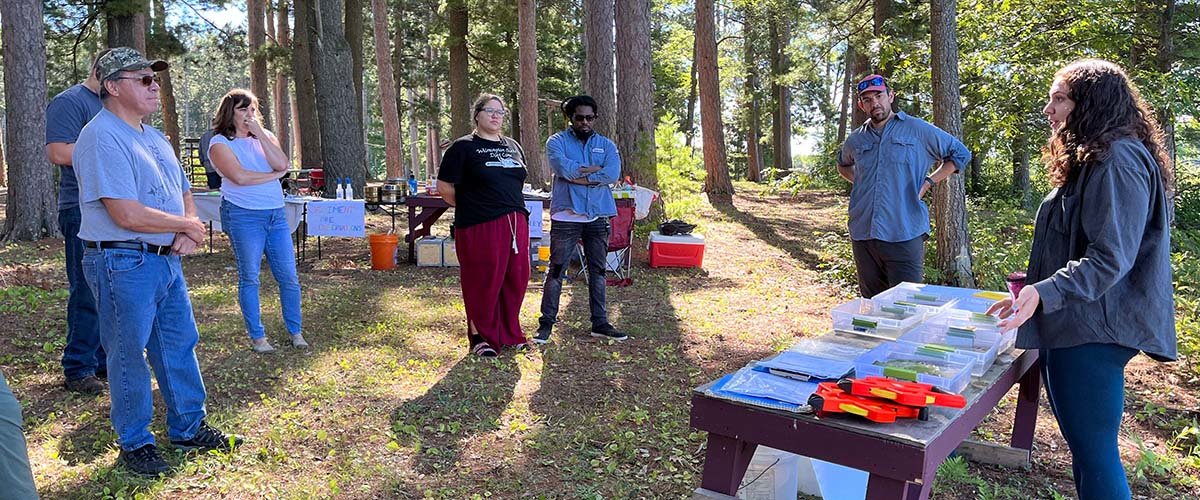
U of M researchers deepen ties with the Lac du Flambeau Ojibwe community to protect wild rice

EMILY GREEN, CONSERVATION BIOLOGY, MS '00
CENTER FOR CHANGING LANDSCAPES
This August, amidst towering red pines on the Lac du Flambeau Band of Lake Superior Ojibwe (LDF) reservation in northern Wisconsin, a group of U of M researchers shared with the LDF community their research methods and the data they had collected on wild rice. Later that day, LDF members demonstrated a few of their traditional practices, including carving white cedar knocking sticks for rice harvesting and deer hide tanning. This was the second in-person “knowledge exchange” for the Kawe Gidaa-naanaagadawendaamin Manoomin (First We Must Consider Manoomin/Psiη) tribal-UMN collaborative to protect wild rice (“Manoomin” in Ojibwe/”Psiη” in Dakota).
Launched in 2018 with U of M Grand Challenges seed funding, this unique collaborative focuses on protecting wild rice / Manoomin / Psiη through research and shared activities that center tribal knowledge and perspectives. The collaborative also includes the Fond du Lac Band of Lake Superior Chippewa, Minnesota Chippewa Tribe, Mille Lacs Band of Ojibwe, St. Croix Chippewa Indians of Wisconsin, the Great Lakes Indian Fish and Wildlife Commission (GLIFWC), and 1854 Treaty Authority.
The vision for collaboration has grown over time. Founding researcher and College of Science and Engineering Assistant Professor Crystal Ng, PhD, initially conceived of a more typical academic research effort — with tribal support — to explore sulfate levels, which are known to harm wild rice at elevated levels. Because the history of U of M research on wild rice is fraught with disrespect for tribal views and sovereignty, Ng heard clearly from the tribal community that this research must be interdisciplinary if the University wanted to work together, and that trust-building with the tribes was an essential, foundational step.
The U of M team prioritized this approach by adding College of Food, Agricultural and Natural Resource Sciences (CFANS) social scientist Mae Davenport, PhD, and interdisciplinary scientist and Citizen Potawatomi Nation tribal member, Mike Dockry, PhD, both focused on exploring human values and beliefs around rice harvesting, stewardship, and landscape change. The team also invested substantial time visiting tribal communities and listening to people’s concerns and stories related to wild rice. Among other things, they recognized the importance of approaching wild rice research with humility as well as honoring and centering tribal views, knowledge, and ways of developing knowledge. Tribal partners urged the U of M team to research wild rice holistically, in a way that recognizes that wild rice interacts with and is impacted by sediments, water levels, climate change, surrounding vegetation, the activities of two-legged and four-legged beings, and many other factors in a complex socio-ecological system.
Tribal leaders also challenged the UMN team to expand the geographic purview of the research beyond Minnesota; wild rice is sacred food and a relative to Ojibwe and Dakota people throughout the Great Lakes region, which includes the areas now called Minnesota, Wisconsin, and Michigan, and is declining across its range. Members of the LDF community were some of the earliest partners to join the collaborative and have been very actively and consistently engaged partners.
In recent years, the collaborative has received additional funding to continue and expand its work from the National Science Foundation (NSF), the National Oceanic and Atmospheric Association (NOAA), and the U.S. Geological Survey (USGS) through the Midwest Climate Adaptation Science Center hosted at the University of Minnesota. Yet while the funding and number of partners has increased, the focus on relationships and true collaboration has remained central.
“I have a lot of respect and a lot of gratitude for this project and what has come out of it thus far. It’s not just a partnership where you talk once a day or once a month, it’s a lot more than that,” said Lac du Flambeau Wild Rice Program Director and tribal council member William “Joe” Graveen. “It’s brought some real deep relationships beyond the professional-academic type of relationship. To me, we’ve built a solid foundation for long-term collaboration and lifetime relationships.”
Get more information on the Kawe Gidaa-naanaagadawendaamin Manoomin project.
Photo above shows conservation sciences masters student Sirena Torres sharing her research on plant species that grow alongside wild rice and how wild rice seed germination is impacted by climate change.





